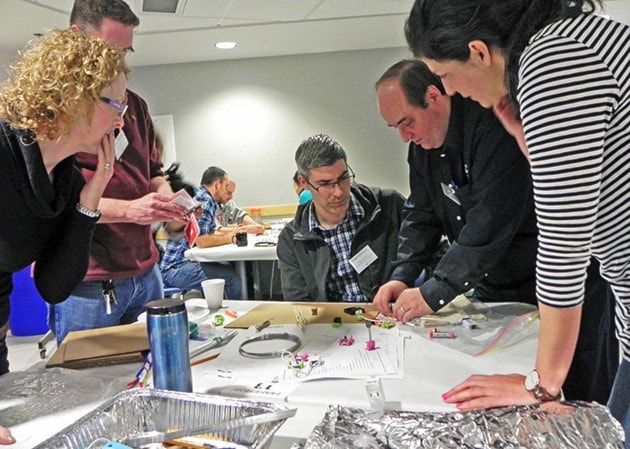"What did you learn today?" is one of the most futile questions from parent to child, almost always followed by a disinterested "nothing."
But it doesn't always mean they aren't learning.
As more teachers embrace hands-on learning, a more apt question could be "what did you make today?"
The culture of education has been shifting toward teaching all students to learn through doing, rather than relying largely on rote learning and memorization of facts. And at the forefront of this culture shift are Dr. Susan Crichton and Deb Carter, from the Innovative Learning Centre at UBC Okanagan. Together with the Industry Training Authority of B.C., they have created something called Maker Days. They've led workshops for students and teachers all over the province over the last two years, and on Friday they came to Chilliwack to offer professional development to Fraser Valley educators.

Quite fittingly, they held Maker Day in the cafeteria of the UFV's Trades and Technology Centre. About 60 educators showed up to take part, and were quickly sorted into teams and given the same task — to create a prototype of a system that would keep animals and livestock fed and free from harm in the event of a flood. It's a very real problem and requires real, workable solutions here in the Fraser Valley.
And it was a challenge that kept these various teachers, administrators and librarians busy all day long. Crichton and a handful of facilitators walked from table to table, watching the eager 'students' go through the whole design process, encouraging them and reminding them of their end goals. The teachers-turned-students moved through collaboration and understanding the task at hand, to creating a workable solution to the problem, right through to the final construction of prototypes.
Some were protective of their intellectual property, others demonstrated their ideas with hand gestures and pieces of the puzzle not quite put together yet. Some looked frustrated, thinking deeply, while others bustled around the room, energized by the task at hand.
Some asked for guidance, and others helped their colleagues.
With the plans in place, each table was handed a kit that included 20 items, including a light and pressure sensors, wires, a buzzer, a 9v battery, a tiny motor, a latch and so on. A pantry was set up with everyday items the participants could make a case for needing, including twine, tubing, tinfoil, zap straps, dowels and PVC piping.
Tools were kept in a shared area, while two 3D printers worked endlessly at creating miniature figures to represent animals in the prototypes.
This is what a classroom should look like, said John English, dean of the Trades and Technology Centre.
It's time to knock down barriers between teaching styles, and erase the notion that students only learn one way or the other.

The education system has a nasty habit of pigeonholing students into streams, with academic at the higher end of learning and the trades somewhere further below. It's a form of classism that begins in schools and carries on outside institutions.
But the time has come for a shift, he said, in a brief interview during Maker Day.
"I oppose that," he said. "I fight it. There are still a lot of people stuck in the past."
Events like Maker Day "transcends all those weird divides," he said, and offer educators a chance to teach all students the power of problem solving, design thinking, and hands-on experimental learning.
While there will always be room for lectures and seminars, practical learning is too important a piece of the puzzle to be relegated to shop classes. Maker Day is intended to teach its participants to imagine, collaborate, tinker, play and create.
They are skills that every person needs, no matter the colour of his or her collar.
Maker Day ended with each team setting up displays of how their prototype would ideally save the animals. Some focused on the mechanics of a gate system, others looked at ways to move herds along, while still others found ways to distribute food and water safely.
The one thing in common for all the projects, was that none of the ideas, the collaboration and the prototypes existed when the students arrived in the morning. But in making those prototypes, the students learned more from each other than they ever could from a book.
